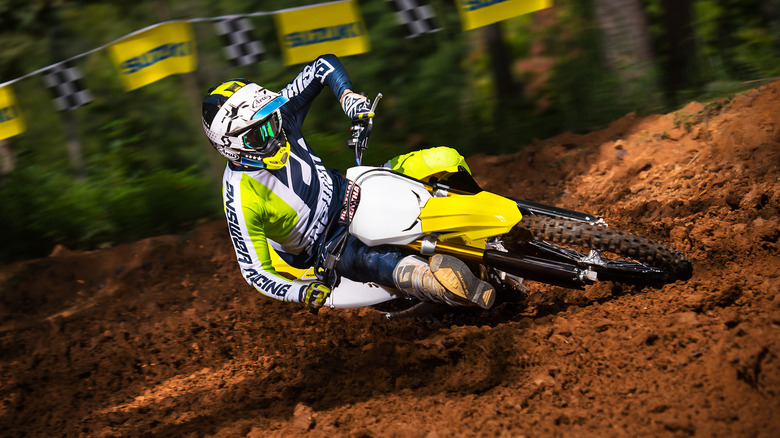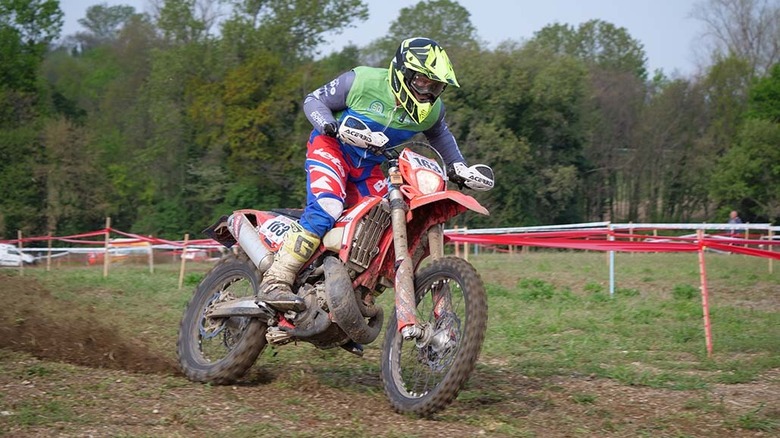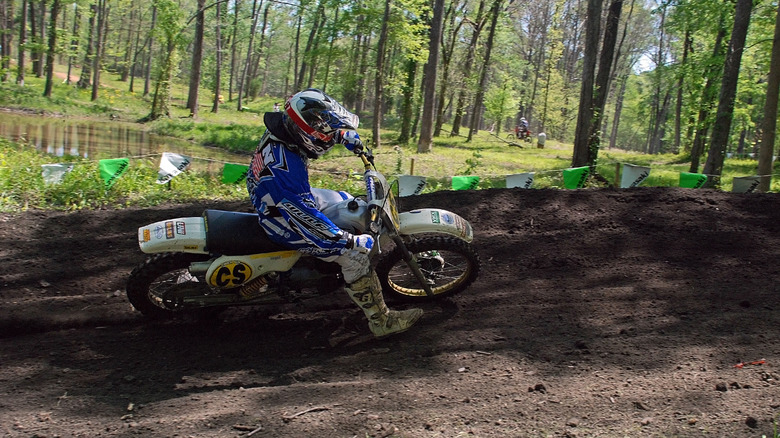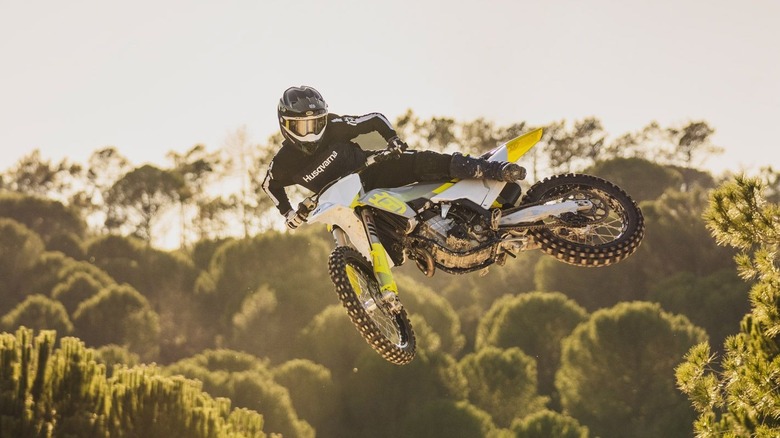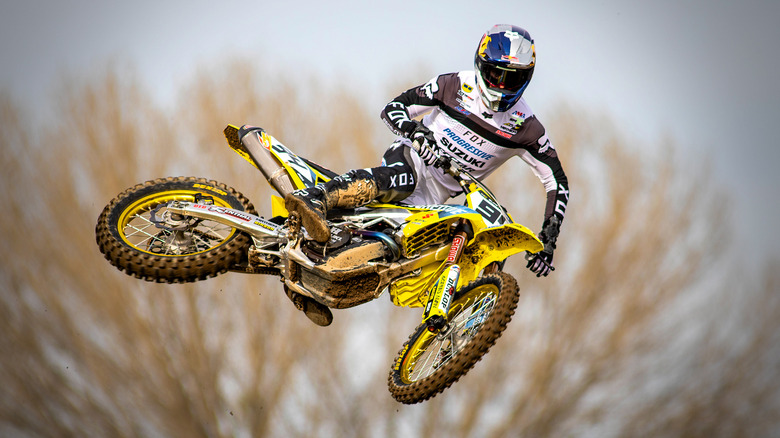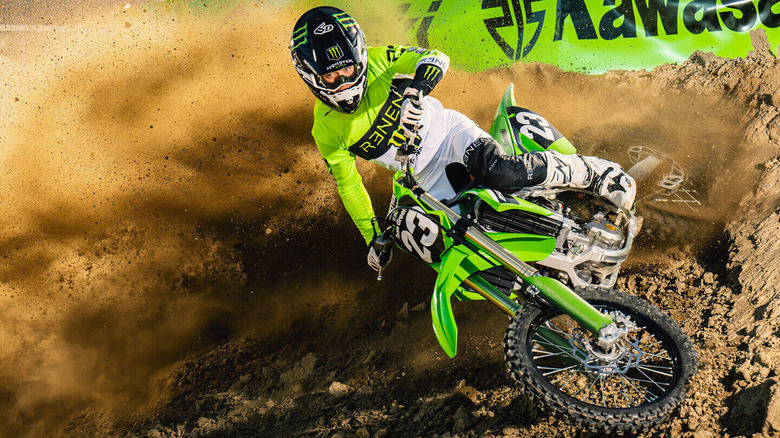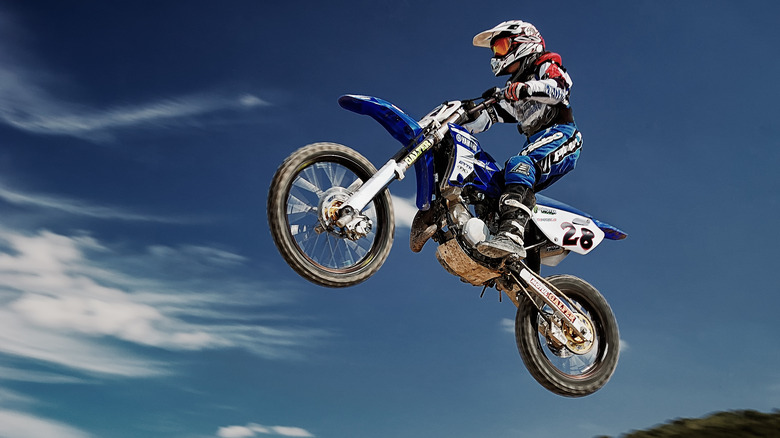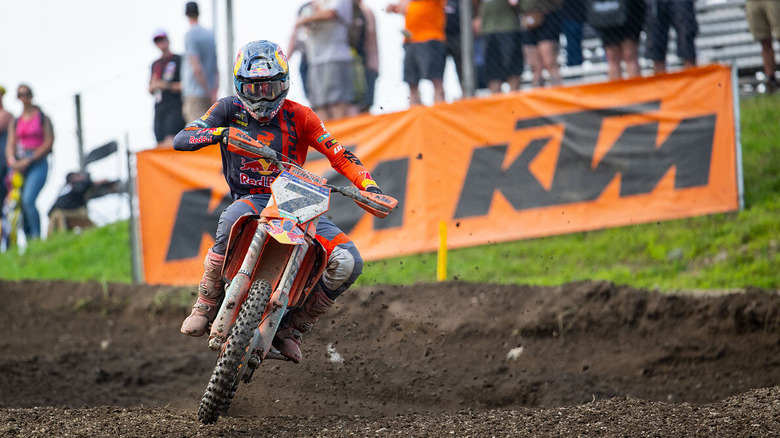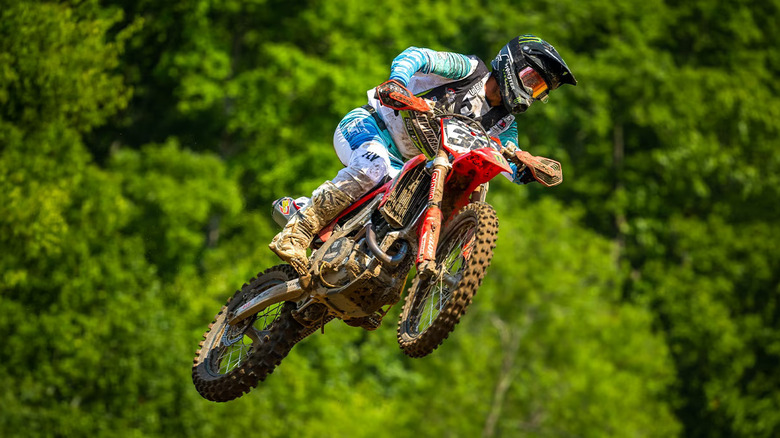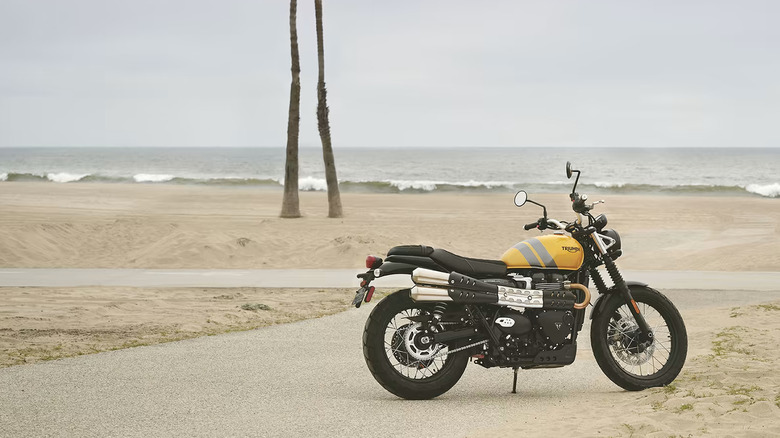Every Major Dirt Bike Brand Ranked Worst To Best
Dirt bikes, or scramblers, are motorcycles designed to be ridden on unpaved surfaces. They are characterized by their large wheels, high ground clearance, long-travel suspensions, and deep-treaded "knobby" tires. There are many subcategories of dirt bikes, including trail, rally, dual-sport, enduro, and motocross machines, each with its own specific set of features for different applications and riding styles.
Whether you enjoy off-road riding at a competitive level or simply like to hit the trail and churn up some mud on the weekend, the sheer enjoyment that comes with riding a dirt bike is hard to beat. Their combination of maneuverability, traction, torque, and power allow them to conquer almost any terrain you throw at them, and their lightweight and flexible properties, combined with their high saddles and wide handlebars, allow for superior balance and control.
While Soichiro Honda could be credited with popularizing the off-road motorcycle, dirt bikes can trace their roots back as far as the early 20th Century. However, it wasn't until the 1960s that Japanese companies, including Honda, Suzuki, and Kawasaki, started producing the first trail bikes that closely resembled the modern dirt bike, a segment these brands still dominate today. Other top brands also make dirt bikes for niche and mass-market consumption while considering their overall build quality, durability, performance, and heritage.
Beta
While it may not be the first name that springs to mind, this Italian company has roots as far back as 1905. Based in the picturesque city of Florence, Italy, Beta Motorcycles produces high-quality machines that are predominantly bespoke racing models. Like many motorcycle manufacturers, Beta started out making bicycles, transitioning to motorbikes in 1948 before turning its attention to off-roaders in the late 1960s. It's still under the ownership of the Bianchi family, making Beta a rare example of a homegrown company with traditional values within this highly competitive industry.
True to their off-road nature, Beta dirt bikes are low on frills but high on build quality. While some models, such as the MY24 enduro range, feature traction control and a limited dashboard, other models, such as the EVO MY 2023, are stripped down to the bare essentials. Having incorporated engines from other manufacturers in the past, including Suzuki and KTM, Beta has built its own engines on all enduro bikes since 2010, to great acclaim.
Team Beta has been a popular fixture in off-road motorsports going back decades and is currently at the top of its game, having won the World Enduro Championships five times in succession between 2017 and 2021. It's also highly competitive in Trial, Super Enduro, and Motocross events, as a testament to the consistent quality of its machines. As far as quality is concerned, Beta is more than a match for top marques, although it's too "niche" to rank highly here.
Maico
Maico is a major brand by reputation rather than by sales. Still, this lesser-known German marque is renowned in dirt bike circles for making high-quality machines, many of which are non-homologated racers, meaning they are not street-legal. The company started making motorcycles in 1926 and expanded its production after World War II. However, it came into its own making motocross and enduro machines and was highly competitive by the 1970s when pitted against the dominant and much wealthier Japanese brands.
The Maico range is small but comprehensive and includes motocross bikes, enduro bikes, and supermoto bikes, each with a choice of 500cc, 620cc, and 700cc engines. They are distinguishable by their red livery with a large logo, but another option is simply pure black with no lettering whatsoever. In typical German style, they are exceptionally well-built, using the highest-quality third-party parts and accessories whenever necessary, and you get the feeling that each and every bike that rolls off the production line is special.
You only have to browse the somewhat dated Maico website to see that this is indeed a small company that focuses more on its product than on appearances. Yet the bikes displayed in the amateurish photographs are of undeniable quality, befitting their prices nearly double that of their mass-manufactured Japanese equivalents. It outlines the fact that dirt bikes of all categories are something of a specialist market, as compared to the many types of roadgoing motorcycles.
Husqvarna
Sweden is home to some of the biggest global companies, including IKEA, Volvo, Spotify, and H&M. Also among these is Husqvarna, a major player in the motorcycle market, and in particular, dirt bikes. While the company was recently acquired by Pierer Mobility, the same Austrian company that owns KTM, it has roots as a metalworking company in Husqvarna, Sweden, as far back as 1689. At the turn of the last century, it started producing motorized bicycles. It turned to motocross in the 1960s, helped in no small part by actor Steve McQueen, a dedicated supporter of the brand.
"Huskies" are renowned for their build quality, with an extensive product line that includes several motocross bikes in 2-stroke and 4-stroke configurations. These are dedicated off-road machines, as evidenced by the lack of an instrument panel, mirrors, headlamps, and rear light clusters. Husqvarna also has a comprehensive race-ready enduro range and two street-legal supermoto models to complete the lineup. Husqvarna is notable for catering to younger riders with its TC range of motocross bikes growing in size from small capacities of 50cc, 65cc, 85cc, and 125cc.
Given its long heritage and the quality of machines that Husqvarna produces, it's surprising that it's not as ubiquitous as its sister company KTM. However, it does have a relatively new line of naked street bikes (the Svartpilen and Vitpilen) that are refreshingly unique in their appearance, as well as the Norden 901 adventure bike that is perhaps a sign of bigger things to come.
Suzuki
Established in the Japanese city of Hamamatsu in 1909, Suzuki has been a major player since the earliest days of motocross, and its celebrated "RM" line of off-road machines has been the choice of many professional riders going back decades. It's known for durable and reliable motorcycles and recognizable for its yellow and blue livery, which are the standard colors of the "RM Army" motocross program. This training scheme offers aspiring racers track days, bike setup coaching, technical advice, and hands-on experience.
The motocross range is small but comprehensive, consisting of the entry-level DR-Z125L and the larger-capacity RM-Z250 and RM-Z450 full-sized machines, and these are all built to Suzuki's high standards and specifications. This off-road product line is complemented by the road-ready "DR" series of supermoto and dual sport bikes for those who need a little more practicality from a two-wheeler and a dedicated line of youth-oriented bikes for aspiring dirt devils. These include the little 50cc DR-Z50, which helps riders get started in motocross for less than $2,600, and the 85cc RM85, which costs around $4,500.
Whether you are a newbie or a pro, child or adult, there is a Suzuki dirt bike to suit you. The company will also shepherd learners through the ranks to become confident and capable riders, with boot camps and after-sale service, should they require it. This suggests that Suzuki cares as much about nurturing the sport as it does providing the equipment, which is an excellent philosophy for any motorcycle company.
Kawasaki
Kawasaki holds the distinction of being the first foreign automotive company to start manufacturing in the U.S., in a disused meat-packing unit in Chicago in 1966. Thanks to its products' robust designs and reliability, the company grew from coast to coast. Now, the Kawasaki Motorcycle Corporation is one of the most well-established brands globally, with 50 years of experience making off-road motorcycles.
The Kawasaki motocross product line consists of traditionally lime green machines with the prefix "KX" and spans youth bikes of 65cc, 85cc, and 112cc, and full-size motocross and cross-country bikes of either 250cc or 450cc. The entire range of race-ready motorcycles boasts highly adjustable suspensions, lightweight aluminum frames, and reliable power units resulting from years of practical experience. They are also more affordable, compared to some of the bespoke brands listed here, with the top-of-the-range KX 450SR costing around $13,000 and fitted with elite components throughout.
Kawasaki motocross bikes are world-renowned and are standard fixtures on racing circuits everywhere. The brand has a dedicated racing program to support amateur motocross riders, and "Team Green" has a loyal following among novice and experienced bikers, providing trackside support for local, regional, and national racing events. This makes Kawasaki a cut above the rest in terms of its commitment to off-road motorsports and a high-ranking player here.
Yamaha
When Yamaha transitioned from manufacturing pianos to producing motorcycles, few would have imagined it would have been so successful. While the three tuning forks on its logo are a nod to its musical roots, it might also allude to the finely-tuned engines that the company produces, which, according to Consumer Reports, are among the most reliable in the industry.
Yamaha has one of the most extensive ranges of off-road motorcycles of any brand, encompassing motocross, country, trail, and dual sport bikes and combining typical Japanese build quality with cutting-edge technology. The "YZ" range of motocross and cross-country bikes (and "WR" street-legal models) are usually recognizable for their blue livery, and the range includes many different engine capacities and configurations. Starting at 65cc for the entry-level junior motocross model, they are also available with 85cc, 125cc, 250cc, and 450cc power units.
Yamaha is a strong presence in motocross with the Yamaha Factory Racing team, which took consecutive professional Motocross and Supercross titles in 2023. The Flagship YZ450F is among the lightest, slimmest, and most agile machines available and can be purchased for under $10,000. Therefore, Yamaha motocross models are not only serious bikes, but they are attainable for those wishing to enjoy the sport as a serious pastime.
KTM
KTM is a rare European leader among the great Japanese marques, no small feat for the Austrian brand. Much like its compatriot export, Arnold Schwarzenegger, it has become ubiquitous as a world-dominating success story and a household name, at least among motorcycle enthusiasts. While its Scandinavian sibling, Husqvarna, is also a very high quality and worthy player in the big league of dirt bikes, Kronreif-Trunkenpolz-Mattighofen has been making dirt bikes since 1973's 250 MX model and has been refining its craft ever since.
The chiefly-orange KTM produces the highly advanced SX range of dirt bikes, available with engine capacities of between 50cc and 450cc in both 2-stroke and 4-stroke configurations. The 2-stroke options offer a better power-to-weight ratio that is supposedly the best in its class, whereas the 4-stroke models are technologically superior, boasting features like quick shifters, traction control, and launch control to maximize potential at the track. The motocross range is bolstered by a selection of enduro and cross-country machines, all of which match the motocross range as far as features, build quality, and advanced manufacturing techniques are concerned.
Thanks to its provision of both 2-stroke and 4-stroke motorcycles, the KTM range is extensive. If racing isn't your thing, then the brand also caters to the sport bike, supermoto, street bike, and adventure bike segments, although cruisers are certainly not in KTMs wheelhouse. Whatever KTM does, it does it well, and statement certainly true of its impressive range of dirt bikes.
Honda
The Honda dirt bike is emblazoned on the public consciousness as the standard upon which all others are based, and given the company's heritage, media presence, and sporting prowess, as well as its products' exceptional build quality and reliability, this is well-deserved.
Since Soichiro Honda first put pen to paper to draft his idea for a motorcycle with deep-treaded tires and a more robust suspension that could be used on grass and unpaved back roads, Honda Powersports has been instrumental in the evolution of the dirt bike. By the 1970s, bikes like the CL100 and CT70 scramblers, with their knobby tires and elevated exhausts, were a sign of things to come. Fast forward a decade, and the XR series had all the characteristics of the modern dirt bike, with high mudguards, large wheels, seat-high tailpipes, long travel front forks, and rear mono-shock suspensions.
Currently, the Honda XR and CRF lines of dual sport and trail models are often the go-to bikes for adventurers, competition riders, and even stunt performers (a CRF 250 was ridden off a cliff in a highly ambitious stunt for "Mission Impossible: Dead Reckoning Part One"). This is a testament to the quality, versatility, and reliability that Honda, as a brand, is known for. And with a choice of styles, configurations, and engine capacities ranging from 50cc for the little CRF50F to 650cc for the XR650L, there truly is a Honda dirt bike to suit anyone who wants to try their hand at off-roading.
Honorable Mentions
While these brands are not specifically known for making dirt bikes, several motorcycle marques have recently entered the off-roader market with one-off models that fall into the dual sport category. One is the Triumph Scrambler, loosely based on its classic Bonneville and available with several engine capacities. Another is the Ducati Scrambler, a surprisingly rugged and versatile dual sport machine from the racy Italian brand. Lastly is the Royal Enfield Scram 411, based on its Himalayan adventure bike, with the same chassis and engine. Each of these machines is as happy on the road as they are off it, and they illustrate the growing trend for modern motorcyclists seeking vehicles that offer more versatility over different terrains, allowing them to go further on two wheels. Their appeal is largely based on the trust each brand has built through its road-ready bikes, and that reputation and competition make for a promising future for riders.
